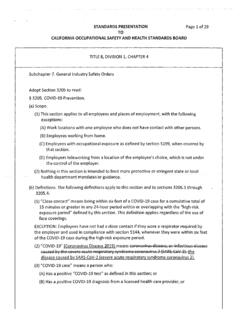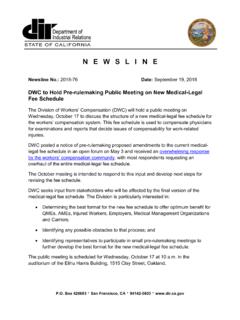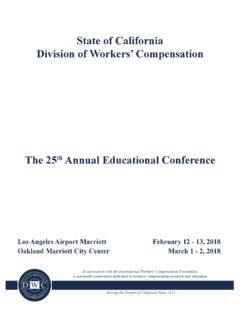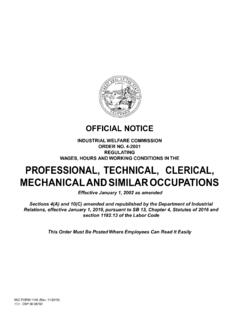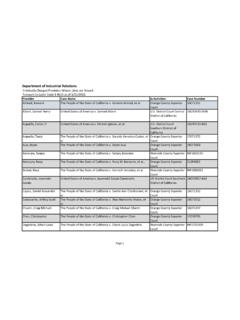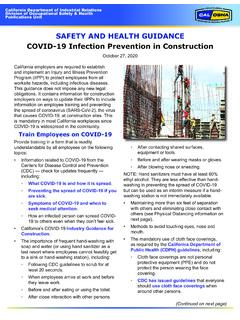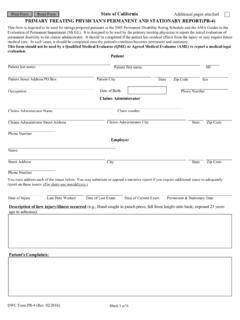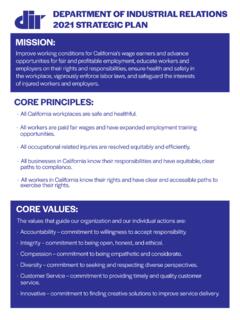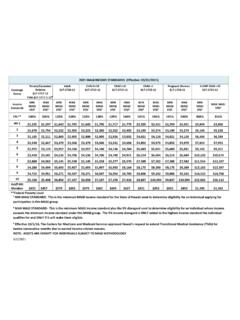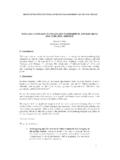Transcription of Revisions to the COVID -19 Prevention Emergency Temporary ...
1 Revisions to the COVID -19 Prevention Emergency Temporary standards ( effective May 6, 2022) Frequently Asked Questions COVID -19 Prevention Emergency Temporary standards The COVID -19 Prevention Emergency Temporary standards remain in effect. The workplace standards were updated in May 2022. The Revisions are in effect until December 31, 2022. More information on the recent Revisions to the COVID -19 Prevention Emergency Temporary standards is available on Cal/OSHA's Frequently Asked Questions. May 7, 2022 Please note: Footnotes describing the updates to these FAQs can be found at the bottom of this webpage. Table of Contents Background What Changed Physical Distancing Respirators Face Coverings Testing Outbreaks Enforcement FAQ Revision and Updates Background Back to top : Why did Cal/OSHA propose revising the COVID -19 PreventionEmergency Temporary standards ?
2 A: Cal/OSHA proposed Revisions to the COVID -19 Emergency temporarystandards (ETS) in light of updated guidance from the California Departmentof Public Health (CDPH) and to make the ETS more flexible if changes aremade to CDPH guidance in the : What is the status of the ETS?A: The following are the effective dates of the ETS: Original ETS: November 30, 2020. First re-adoption: June 17, 2021. Second re-adoption: January 14, 2022. Third re-adoption: May 6, : What are the effective dates of this version of the ETS?A: This latest ETS update is effective from May 6, 2022 through December31. Changed Back to top : What are the important changes in the May 6, 2022 revised ETS?A: The important changes include the following:oDefinitions. Some of the definitions in the ETS were revised.
3 ( Regs., tit. 8, 3205(b)) The definitions of close contact and infectious period are nowdefined so that their meaning will change if CDPH changes itsdefinition of the term in a regulation or order. This will allow moreflexibility and consistency with CDPH. The definition of COVID -19 test was simplified to make it easierto use self-administered and self-read tests. A video orobservation of the entire test process is no longer necessary; justa date/time-stamped photo of the test result will now besufficient. The definition of "fully vaccinated" was deleted as this term is nolonger used in the regulations. All protections now apply regardlessof vaccination status and ETS requirements do not vary based onan employee s vaccination Face Coverings.
4 Changes were made to face covering requirements (Cal. Code Regs., tit. 8, 3205(c)(6) Face coverings requirements are the same for all employees regardless of vaccination status. Face coverings are no longer mandatory for unvaccinated workers in all indoor locations. Face coverings are mandatory in the ETS when CDPH requires their use, which currently includes the following indoor settings, regardless of vaccination status (this list will change if CDPH changes their requirements): Emergency shelters Cooling and heating centers Healthcare settings Correctional facilities and detention centers Homeless shelters Long term care settings & adult and senior care facilities o Cleaning and disinfecting requirements were deleted (Cal.))
5 Code Regs., tit. 8, 3205(c)(7)) o Respirators must be provided for voluntary use to employees who request them and who work indoors or in vehicles with other persons. This now applies to all employees where previously it only applied to unvaccinated employees. This is consistent with changes made throughout the regulation to provide the same protections to all employees regardless of vaccination status (Cal. Code Regs., tit. 8, 3205(c)(7)(C)). o COVID -19 testing must be made available to all employees with COVID -19 symptoms. As with respirators, this now applies to all employees regardless of vaccination status whereas previously it only applied to unvaccinated employees (Cal. Code Regs., tit. 8, 3205(c)(7)(D)). o Exclusion of employees who had close contact.
6 The detailed prescriptive requirements for exclusion of employees after close contact have been deleted. Instead, employers must review CPDH guidelines for employees who had close contact and implement quarantine and other measures in the workplace to prevent COVID -19 transmission in the workplace. This allows for greater flexibility in the regulations (Cal. Code Regs., tit. 8, 3205(c)(9)). For more information, please refer to the section on CDPH's Isolation and Quarantine Guidance in the general FAQs, and to Cal/OSHA s fact sheet on quarantine and isolation. o Exclusion of employees with COVID -19. The requirements for employees who test positive for COVID -19 have been updated to reflect the most recent April 6, 2022 CDPH isolation and quarantine guidelines.
7 Regardless of vaccination status, employees who test positive can return to work after 5 days if the employee has a negative test, symptoms are improving, and they wear a face covering at work for an additional 5 days. Otherwise most employees can return after 10 days. (Cal. Code Regs., tit. 8, 3205(c)(10)). For more information, please refer to the section on CDPH's Isolation and Quarantine Guidance in the general FAQs, and to Cal/OSHA s fact sheet on quarantine and isolation. o Outbreaks Testing and Exclusion. Employees who had close contacts must test negative or be excluded from the workplace until the return to work requirements for COVID -19 cases in are met. (Cal. Code Regs., tit. 8, (b)(2)(C)) Partitions/barriers. Employers no longer need to consider the use of barriers or partitions to reduce COVID -19 transmission in outbreaks.
8 These requirements have been deleted. (Cal. Code Regs., tit. 8, (d)(3)) o Major Outbreaks Testing and Exclusion. All employees in the exposed group must test negative or be excluded from the workplace until the return to work requirements for COVID -19 cases in are met. (Cal. Code Regs., tit. 8, (b)) Partitions/barriers. Similar to the regular outbreak section, partition and barrier requirements have also been deleted and are no longer required. (Cal. Code Regs., tit. 8, (c)) o Employer-Provided Housing. Immunity status. Exceptions for fully vaccinated and recently recovered residents have been deleted and protections in this section apply to all residents regardless of their immunity status. (Cal. Code Regs., tit. 8, (a)(5) and (g)) Cleaning and disinfecting requirements have been deleted and are no longer required.
9 (Cal. Code Regs., tit. 8, ) o Employer-Provided Transportation Vaccination status. An exception for fully vaccinated employees has been deleted and protections in this section apply to all vehicle occupants regardless of vaccination status. (Cal. Code Regs., tit. 8, ) Face coverings. Mandatory face covering use by all in vehicles has been deleted. Instead of this requirement, employers must review CDPH and local health department recommendations regarding face coverings and implement face covering policies that effectively eliminate or minimize COVID transmission in vehicles. (Cal. Code Regs., tit. 8, (c)(2)) There is a new requirement for employers to train employees on CDPH and local health department recommendations regarding face coverings and the employer s policies.
10 (Cal. Code Regs., tit. 8, (c)(3)) Cleaning and disinfecting requirements have been deleted and are no longer required. (Cal. Code Regs., tit. 8, ) 2. Q. Are there requirements from the previous version of the ETS that will remain in place? A: Yes, they include but are not limited to the following requirements: o Establishing, implementing, and maintaining an effective written COVID -19 Prevention Program. o Providing effective training and instruction to employees on the employer s Prevention plan and their rights under the ETS. o Providing notification to public health departments of outbreaks. o Providing notification to employees of exposure and close contacts. o Offering COVID -19 testing after potential exposures. o Requirements for responding to COVID -19 cases and outbreaks.

